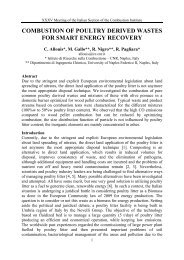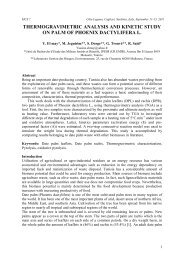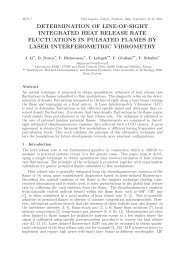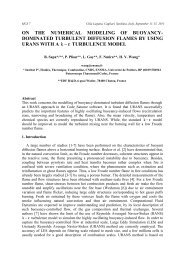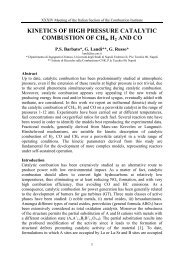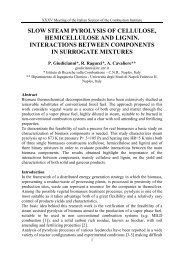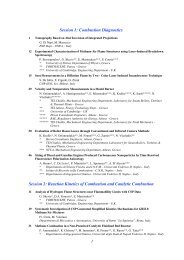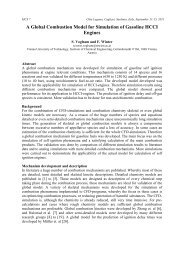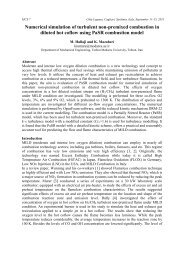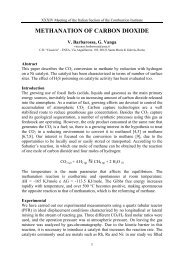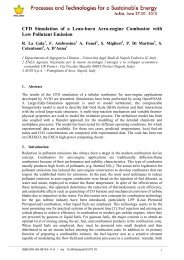SHORT CONTACT TIME CATALYTIC PARTIAL OXIDATION OF CH4 ...
SHORT CONTACT TIME CATALYTIC PARTIAL OXIDATION OF CH4 ...
SHORT CONTACT TIME CATALYTIC PARTIAL OXIDATION OF CH4 ...
Create successful ePaper yourself
Turn your PDF publications into a flip-book with our unique Google optimized e-Paper software.
XXXV Meeting of the Italian Section of the Combustion Institute<br />
CPO experiments with methane-hydrogen mixture were run by increasing the H 2<br />
content in the fuel blend, at fixed equivalence ratio and nominal input power:<br />
steady state catalytic performances for the unmodified Ni foam and for Pt- or Rhmodified<br />
catalysts were almost identical, as shown in Fig. 2 a-d for the case of φ=4.<br />
The partial substitution of methane with H 2 caused a progressive increase of the<br />
temperature of the catalytic foams (in Fig. 3a for Pt-Ni catalyst) and of the product<br />
syn-gas, in agreement with the trend of the adiabatic equilibrium temperature (Fig.<br />
2a), that increases because of the higher heat of combustion of H 2 per mole of<br />
oxygen [8] and the lack of endothermic chemistry with respect to methane.<br />
Methane conversion (Fig. 2b) increased progressively with increasing the hydrogen<br />
content in the fuel mix, due to higher temperatures on the catalyst and higher<br />
partial pressures of water speeding up the kinetically limited steam reforming<br />
reaction. CO selectivity (Fig 2c) raised slightly approaching the equilibrium value<br />
for the highest hydrogen contents.<br />
T g<br />
out °C<br />
CH 4<br />
conversion %<br />
1100<br />
1000<br />
900<br />
800<br />
700<br />
100<br />
90<br />
80<br />
70<br />
60<br />
50<br />
0.0 0.2 0.4 0.6 0.8<br />
y H 2<br />
fuel<br />
0.0 0.2 0.4 0.6 0.8<br />
y H 2<br />
fuel<br />
Ni<br />
Rh-Ni<br />
Pt-Ni<br />
4<br />
CO selectivity %<br />
H 2<br />
out /O 2<br />
in<br />
100<br />
90<br />
80<br />
70<br />
60<br />
50<br />
5<br />
4<br />
3<br />
2<br />
1<br />
0<br />
0.0 0.2 0.4 0.6 0.8<br />
y H 2<br />
fuel<br />
0 1 2 3<br />
H 2<br />
in /O 2<br />
in<br />
Figure 2. Effect of the H 2 content in CH 4 -H 2 fuel blends during the CPO in air at<br />
fixed input power (0.38 kW) and equivalence ratio φ (4.0) over pure Ni foam, Rhand<br />
Pt-modified catalysts: a) temperature of the gas leaving the catalyst, b) CO<br />
selectivity, and c) methane conversion as a function of yH 2 ; d) hydrogen<br />
production expressed as H 2 out /O 2 in vs. H 2 in /O 2 in . Dashed lines represent<br />
thermodynamic equilibrium values (p, H=constant).<br />
Fig. 3a,b illustrate the qualitative analogy in the trends of methane conversion and<br />
surface temperatures observed at three levels of the feed equivalence ratio as a<br />
function of yH 2 in the fuel. As expected, lower values of φ, corresponding to<br />
higher quantities of oxygen (the limiting reactant) in the feed, were responsible for



